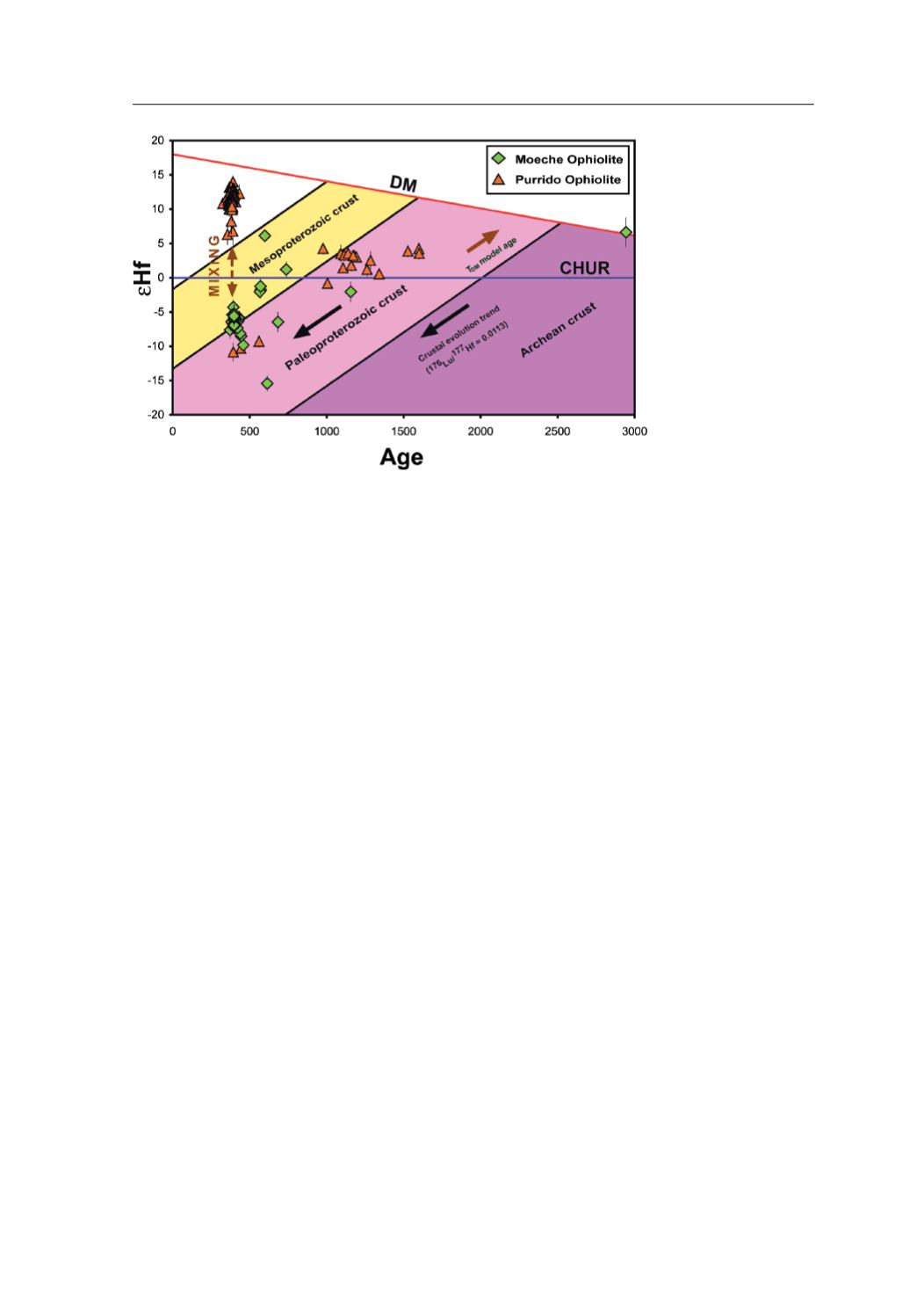
regional fabric of the rest of the Upper Ophiolitic
Units.
Lower Ophiolitic Units
Vila de Cruces Ophiolite
Located in the SE of the Órdenes Complex, the
Vila de Cruces Ophiolite shows an intricate in-
ternal structure formed by two main juxtaposed
slices totaling
c.
4000 m in thickness (Fig. 4). It
is mainly composed of greenschist with prob-
able volcanic protoliths, which alternate with
phyllites, pelitic micaschists, semipelitic schists
with porphyroblasts of albite and garnet and rare
metacherts. Other lithologies include some lens-
shaped alternations of metagabbro and two lay-
ers of tonalitic orthogneiss transitional to gabbro.
In the contact zone between the two main slices,
some rather thin intercalations of serpentinites
occur. Both the mafic and felsic metaigneous
rocks have compositions typical of magmas gen-
erated in destructive plate margins (Fig. 12d). The
greenschists and metagabbros show island-arc
tholeiite compositions and a marked negative Nb
anomaly in relation to N-MORB (Fig. 12d), sup-
porting a supra-subduction zone setting for this
ophiolite (Arenas
et al.
, 2007b).
In the orthogneisses, a first U-Pb zircon study
yielded a protolith age of 497 ± 4 Ma (Arenas
et
al.
, 2007b). However, based on the discovery of
some zircon grains giving inaccurate Mesopro-
terozoic ages (
c.
1168-1176 Ma) in two samples
of metagabbro, this unit was interpreted as a
composite terrane rather than a single ophiolite
(Sánchez Martínez, 2009; Sánchez Martínez
et al.
,
2009). Additional U-Pb dating yielded consistent
ages of
c.
500 Ma for one sample of gabbro and
three orthogneiss samples (Sánchez Martínez
et
al.
, 2013). This age is currently considered as the
crystallization age for the igneous protoliths of
the Vila de Cruces Ophiolite. In spite of the ab-
sence of Lu-Hf zircon data in this unit, the pres-
ence of Mesoproterozoic zircons is considered as
evidence for interaction of the igneous protoliths
with continental crust.
The Vila de Cruces Ophiolite is characterized
by a pervasive regional schistosity that transects
a previous schistosity. Both planar fabrics are as-
sociated with different generations of map-scale
recumbent folds and formed under greenschist
facies conditions (Arenas
et al.
, 2007b). The P-T
values are higher in the upper part of the unit,
where they can reach the amphibolite facies or
transitional conditions. In these upper levels, the
mica-schists contain garnet-chlorite-white mica,
but not biotite, which suggest that part of this
unit was affected by an initial high-P metamor-
phic gradient. On the other hand, the regional
foliation has been dated at
c.
363-367 Ma in two
phyllite samples (
40
Ar/
39
Ar dating on white mica
concentrates; Dallmeyer
et al.
, 1997).
The Vila de Cruces Ophiolite is interpreted as
a supra-subduction zone ophiolite developed in
a Cambrian back-arc opened in the periphery
35
3. GEOLOGICAL FRAMEWORK
Fig. 14.
Initial
H
Hf ver-
sus age diagram com-
bining the U-Pb and
Lu-Hf isotope data of
zircons from the Purrido
and Moeche ophiolites.
Crustal evolution trends
(
176
Lu/
177
Hf = 0.0113) for
the Archean, Paleopro-
terozoic and Mesopro-
terozoic crusts are also
shown. Based in Sánchez
Martínez
et al
. (2011) and
Arenas
et al
. (2014b).








